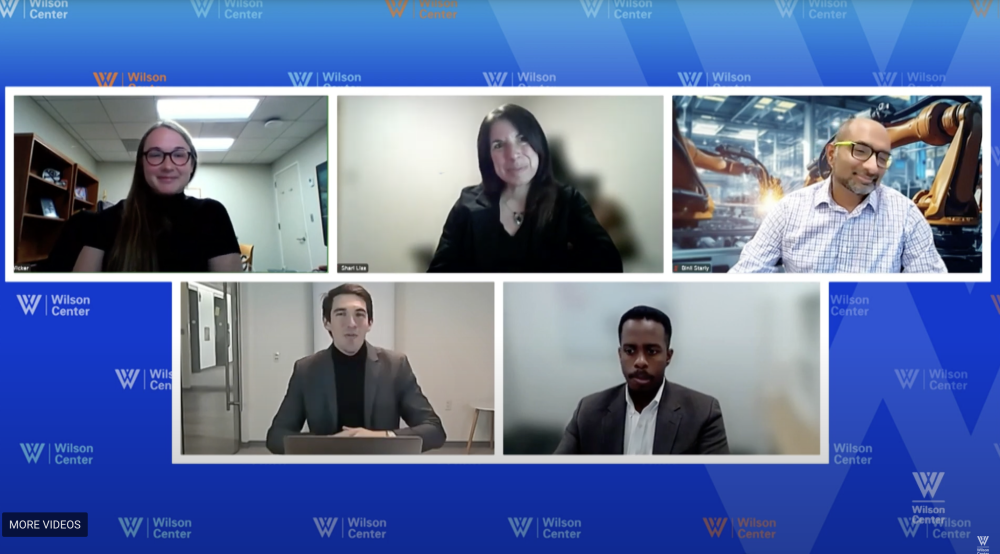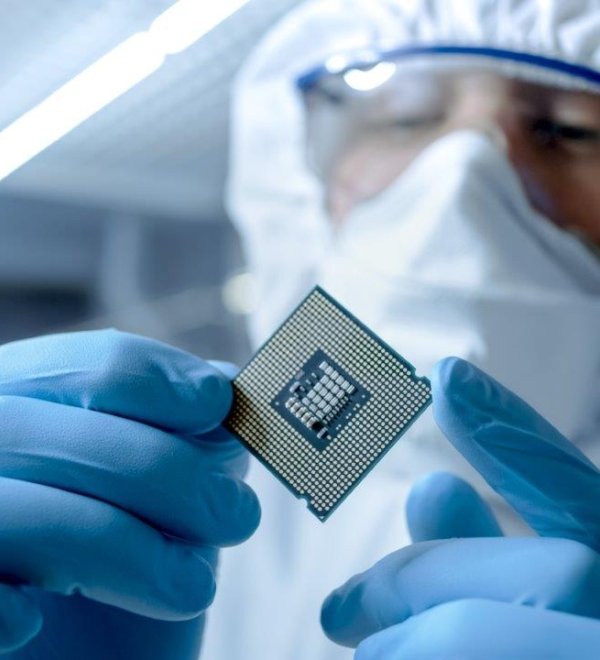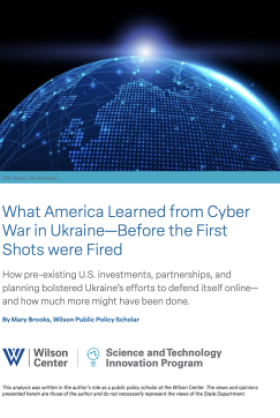
A blog of the Science and Technology Innovation Program
Event Summary | Looking Deeper: Reshoring and the Semiconductor Workforce
In this second part of the three-part series on semiconductors and the impact of the CHIPS Act, we ask the question: can the United States keep up with workforce demands?

Photo taken during the event

Looking Deeper: Reshoring and the Semiconductor Workforce
Watch NowIntroduction
“The United States is projected to face a shortfall of 70,000 to 90,000 technicians, computer scientists, and engineers in the semiconductor industry by 2030,” opened Kellee Wicker, director of the Science and Technology Innovation Program at the Wilson Center and moderator for the Wilson Center’s second edition of Looking Deeper. Panelist Shari Liss, executive director of the SEMI Foundation, pointed out that these numbers from industry giant Intel may be conservative, saying “When we look at the fuller ecosystem that supports this industry, we’re looking at a lot of jobs outside that 70-90,000.”
Though the recent CHIPS and Science Act of 2022 provides $52.7 billion for semiconductor manufacturing, R&D, and workforce development, money alone cannot boost US competitiveness and innovation. As the US government tries to catalyze the semiconductor industry, it will have to reckon with a considerable workforce shortage. In light of this, the Wilson Center convened panelists from industry, higher education, and the nonprofit world to talk details on the semiconductor workforce shortage and ways the United States can reshore production.
Meeting the Demand for Workers
Semiconductors are a driving force in technological breakthroughs, and yet, generating excitement for working in the semiconductor industry remains one of the biggest challenges to overcoming the workforce shortage.
Bo Machayo, director of Federal Government and Public Affairs for Micron Technology, discussed how Micron is innovating the way they engage with communities and breaking down barriers to working in the industry. Machayo explained that “for women and families, we have identified childcare as a barrier. Putting childcare facilities on-site allows for an ease of mind as you raise your family.” Earlier this year, Micron announced an initial $500,000 investment in YMCA of Central New York to expand access to high-quality childcare for working families.
Even though filling fabs now is the immediate focus of the workforce shortage, Liss noted that “if we don’t invest in the K-12 space, we’re going to continue to have this challenge.” The SEMI Foundation partners with companies, state governments, and school districts to teach students about the semiconductor industry. Working with Roadtrip Nation, the SEMI Foundation launched a video series about three young adults exploring careers in this industry, which has gained more than a million views since they shared it with educators across the country.
Daniel Kroth, associate director for Society at the Special Competitive Studies Project and former research analyst at the Wilson Center, mentioned that programs that build interest in STEM careers “need to start early because you never know who is going to make the difference.” In this spirit, the SEMI Foundation shares hands-on projects like building an air pollution sensor with students in the third and fourth grades. Liss noted that this is a critical age where students in groups traditionally underrepresented in STEM start to lose confidence in their potential to be scientists or engineers. Initiatives like these and many others prove that reducing barriers to entering the semiconductor workforce and fostering passion for STEM careers in the next generation are key steps to reducing the workforce shortage.
Training the Workforce
Drawing more students to engineering degrees is just the first step to solving the workforce shortage. Machayo pointed out that beyond just engineers, there is also a great need for technicians and tradesmen. Kroth asserted that the US semiconductor industry will need a 5-fold increase in graduates from technical skills programs by 2030.
Alarmingly, many existing technical skills programs and engineering degrees do not prepare students with the experience they’ll need to be competitive in the semiconductor industry. Dr. Binil Starly, director and professor of the School of Manufacturing Systems and Networks at Arizona State University, commented that “it’s not just about graduating people, it’s about graduating people with the right skills.” Starly believes that giving students practical experience in fabs is critical to bridging the skill gap. Arizona State University is doing just that with their Fabrication Lab, a digital space that allows students to experiment with and explore fabrication processes. Micron is aiming to extend similar resources to students at community colleges; Machayo mentioned that Micron invested $5 million to fund a 5,000 square-foot clean room simulation lab at Onodaga Community College.
The panelists agreed that apprenticeship programs, particularly ones that follow an ‘earn and learn model,’ are also vital to reducing the workforce shortage. Not only do new semiconductor apprenticeship programs allow students and workers to take classes while gaining practical, on the job experience, they are also shortening the time it takes to gain credentials from four or five years to just 18 months.
How the CHIPS Act Changes the Landscape
The CHIPS and Science Act has enabled massive amounts of funding to be allocated towards the semiconductor industry. Machayo shared two record-breaking projects that Micron announced after the bill’s passage: a plan to invest $15 billion in a leading-edge memory manufacturing fab in Boise, Idaho and a $100 billion investment in Clay, New York to build a megafab. Both are the largest ever private investments in their state’s history.
With CHIPS facilitating projects such as these across the country, the need for skilled workers is sure to grow. The consequences of this growing shortage extend beyond technology companies; Starly explained that workers in the semiconductor industry make critical contributions to the United State’s national security and economic stability. A fragile supply chain in the semiconductor industry has profound effects on the strength of the nation as a whole.
Thankfully, the CHIPS and Science Act is causing a shift in the semiconductor industry which aims to meet this challenge. Liss credited CHIPS for the growth in apprenticeship programs, adding, “The apprenticeship model in the US in the semiconductor model was not viable a year and a half ago, so shifting how we hire, how we train, shifting away from degrees for everything, is new and very exciting, and credited to CHIPS.”
The Act has had other impacts as well. Machayo revealed that the bill has also caused Micron and companies like it to focus more on skills and competency-based hiring, noting that “50% of all the jobs that are going to be available in the semiconductor industry don't require two degrees,” a substantial deviation from the norms of the tech industry. To successfully make this shift, the semiconductor industry is building connections with communities like unions and veterans. Micron has announced Project Labor Agreements with numerous local trade unions and reported 17% of hires being veterans, far exceeding the national average of 5%.
Kroth noted that there is still work that can be done on the national level to reduce the workforce shortage; he suggested that changes to the H1B Visa—a nonimmigrant work visa that allows US employers to hire foreign workers with specialized skills to work in the United States—would go a long way in bolstering the workforce. Better infrastructure to teach specialized STEM skills outside of post-secondary programs are also key to long-term sustainability. Liss hopes that the CHIPS and Science Act avoids a “siloed” approach by building a national network to include private companies, advocacy groups, K-12 educators, 4-year universities, community colleges, and state governments. Proactive strategies across all of these levels are essential to solving the workforce shortage and ensuring long-term sustainability for the domestic semiconductor industry.
About the Author


Science and Technology Innovation Program
The Science and Technology Innovation Program (STIP) serves as the bridge between technologists, policymakers, industry, and global stakeholders. Read more

Wahba Institute for Strategic Competition
The Wahba Institute for Strategic Competition works to shape conversations and inspire meaningful action to strengthen technology, trade, infrastructure, and energy as part of American economic and global leadership that benefits the nation and the world. Read more














